Cameron’s birth was a great, empowering experience. Just how I was hoping it would go. What I didn’t know was that immediately after he was born, things would go in a really unexpected direction and that I would end up in the ICU. Like many moms, I spent a small amount of energy worrying about how the birth would go – would the baby be OK? And he was and is. But things didn’t go quite as smoothly for me, and I feel grateful to be here today to be able to write this story down as part of the process of moving on from the experience.
Cameron’s Birth
It was Saturday, April 9th. I was one week past my due date, which was mostly fine with me. I was hoping things would get going with labor soon, though, since my mother-in-law was leaving town on Tuesday after being in town for two weeks. Our plan was to have her take care of Brooklyn while I was in labor and then for a few days in the hospital, and I was hoping we wouldn’t have to send her back home without her having gotten the chance to meet her grandson.
Our doula Renata (a doula is someone to coach and support moms through their pregnancy, delivery, and postpartum experience) had made some suggestions throughout the week about some ways to induce labor naturally, and so I’d tried some of those. I was even going for walks every day at this point to try to move things along, which was very painful for me given that I had developed SPD (symphysis pubic dysfunction – a condition that doesn’t impact the baby or cause complications but is very painful and doesn’t resolve until the baby is born).
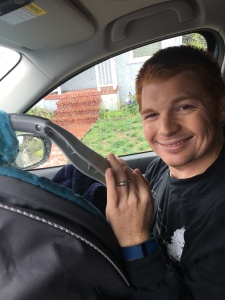
The play structure took up even more space than we anticipated, so here’s Jon holding one of our removed car seats in the front seat on our drive to the restaurant.
Jon and I had discussed buying a small outdoor play structure for Brooklyn to play with this spring and summer and we’d located a used one in Richmond on Craigslist. While Jon’s mom took Brooklyn to the library, we got in the car and headed to pick up the play structure at about 11:30am. On the drive, I started feeling some crampy pains and was hopeful that this was labor. We arrived and it took quite a while to load the structure in the rain. The woman who sold us the structure asked how far along I was, and when I told her I was 41 weeks, she said that she had read about an essential oil that can induce labor and would I like some? Sure, why not. She brought some out and I rubbed a bit on my wrists.
The pains continued, and when we left I timed a few of them – 3 minutes apart. I was getting more hopeful that this was it, so I suggested we go to lunch since it would likely be one of our last chances to do so alone for quite a while. We decided on Juan’s Place – a great Mexican spot in Berkeley where we had gotten takeout on the night we got engaged. #besttortillachips
We called our doula before going inside to give her the update. During lunch the pains got more intense, but still manageable. We headed home after that and went upstairs to our room so that I could have a quiet place to be while things progressed. Being me, I sent off a few quick emails and printed off a few forms to put in the mail for FSA reimbursements. #alwaysworkingonmylist
The contractions increased to a point where I needed to pause the conversation during them, and Jon started helping me get through them with the double hip squeeze, a strategy that was magic for me during Brooklyn’s labor and delivery.
Renata joined us a few hours later and helped me get into positions to help the contractions be more productive (squatting, for example), and also reminding me to breathe through them and relax my body instead of tensing up. It’s amazing how intuitive it is to tense up during pain like that, and how counterproductive that tension is. Deliberately relaxing all the parts of your body makes such a difference in how you experience that pain. I appreciated her reminding me every time I got caught up and was tensing my jaw, my hands, etc.
I had a slight fear of delivering the baby outside of the reach of medical professionals – not because I was worried about the delivery itself (I even told people in the weeks before birth that I felt like I would be fine delivering just about anywhere if I had to), but because I wanted to be sure that if the baby needed any medical attention upon arrival that we’d have access to that. Given that, I decided that I was ready to head to the hospital around 5:30 pm or so. We spent about another hour doing a few more strategies to move things along and get things ready (loading the car, saying goodbye to Brooklyn, putting stamps on those forms to be mailed, etc.) and arrived at the hospital at 7pm.
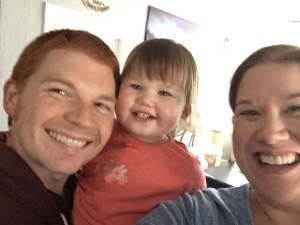
Last picture as a family of 3 before heading to the hospital. About 3 hours before Cameron joined us!
In triage, the doctors checked and told me I was 7cm dilated (for those of you unfamiliar with birth, you’re aiming for 10cm dilated to start pushing), which was great news. Several nurses commented that I didn’t seem like I was in labor at all – apparently I was much more calm and smiley than they are used to for someone at this stage in labor. If that’s true, the credit goes to Jon and Renata for helping me effectively get through the contractions so that I could relax (and even do a little dancing) between them.
By 8pm, we were in a labor room where we got settled and Jon put on my most recent playlist from my phone (which, it turns out, is more than 50% T-Pain – perhaps good music to help dance a baby out?) and I got through most of the contractions standing up with Jon and Renata to coach me through. When things started getting tough to get through, I asked Jon to show me videos of Brooklyn, and those were really helpful in taking my mind off the contractions at least a little bit. Things progressed quickly.
By 9pm, I was having incredibly strong contractions and was fully dilated. I let folks know that I was going to start pushing. The amniotic sac was bulging but had not yet broken. The midwife (Kaiser Oakland uses midwives and residents instead of obstetricians for low-risk births) told me that they could break my water and it might help speed things up. At that point, I was ready for this baby to be born and I enthusiastically agreed. We’re not sure exactly how long I pushed this time (with Brooklyn, I pushed for more than 4 hours – whew), but we think it was about 20 minutes. It was INTENSE. Much more intense than I remember the pushing with Brooklyn to be. It felt like he was crowning for what seemed like forever. Renata kept encouraging me to look at Jon’s eyes, and his smiles and encouragement really carried me through those very intense minutes. He was helping me count through the pushes, and I remember being unable to push for more than a few seconds at a time because I needed to stop to breathe.
As women who have had babies know, laying on your back while pregnant and especially while in labor is really not comfortable. I was most comfortable either standing up or on my knees for this part of labor, and so that’s the position I decided to push in and deliver the baby.
After those 20 minutes or so, he was born! I flipped over onto my back and they handed him to me with the cord still attached. They delayed the cord clamping at my request for a little bit of time, and then Jon cut it. He was a big guy! 9 lbs 12 oz and with a 99th percentile head circumference. We noticed how much hair he had – so much more than Brooklyn had at birth. He was immediately a champ at breastfeeding, and I was just blissed out – proud of the strength of my body and mind in creating and delivering this beautiful baby boy. This was the birth experience I had been hoping to have.
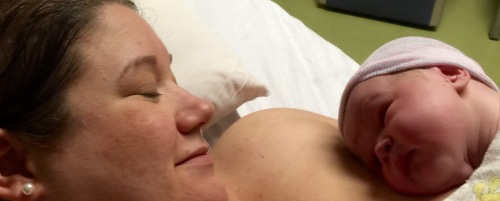
A few minutes after birth.
Placenta Accreta
Within a number of minutes, things changed for the worse. In a normal birth, after the baby is born, the placenta is delivered. This typically happens within half an hour of the baby’s birth (it was within just a few minutes of Brooklyn’s birth).
My placenta wasn’t being delivered as expected. At first, the language used by the doctors was that it was just taking a little longer than expected. But after a long time of trying to deliver the placenta, it was clear that it was not going to come out on its own. And a placenta cannot just stay in – if it does, it can cause a mother to bleed out.
At this point, we needed to try to manually extract the placenta. They tried this in the labor and delivery room, and it was a painful process. It did not work.
The next step is to do a more intense version of this in an operating room with a spinal block to manage the pain. I was upset to have to leave Jon and the baby to have this done, but I was confident that it would be successful and I’d be back with them in an hour or so.
The procedure was not successful. While the doctors were able to remove a part of my placenta, not all of it would come out. During the procedure, I lost a significant amount of blood and had my first blood transfusions of the day. They decided to try for a long shot – waiting to see if my body would absorb the remaining part of the placenta. This was unlikely to work, but was much preferable to the alternative.
It turns out that I had placenta accreta, which is where the placenta attaches too deeply into the uterine wall. This is a rare condition – about 1 in 2,500 pregnancies, and even less likely for someone with no risk factors. There are a variety of risk factors (prior C-sections, miscarriages, or abortions, being over age 35, etc.), but I had none of them. There are symptoms (having a pre-term baby, bleeding during pregnancy, etc.), but I had none of them. I am nearly the poster child for a woman who is highly likely NOT to experience placenta accreta, in fact. But, alas. Just an extremely unlucky turn of events, and not one anyone could have predicted (this is so rare and can be hard to diagnose, so it’s not something that is screened for in pregnancy unless there is a reason to believe a woman is at risk).
I was taken to a recovery area where Jon and the baby were able to spend time with me – I was grateful to be with them, but I was in a lot of pain. My body was trying to deliver the placenta, and so I was having very strong regular contractions. I was also continuing to lose blood. Through this, I was trying to enjoy this new baby boy and establish a strong nursing relationship (the nursing was likely making the contractions worse, but it was important to me to breastfeed him as much as I could in this first day of life). Jon remembers this time as being very tired (we’d been up all night), with alarms going off all the time as my heart rate would change and with me so groggy that I’d fall asleep mid-sentence. He remembers Cameron being pretty relaxed – we’re grateful for that.
I spent about 12 hours in this state – strong contractions, loopy on pain meds, trying to nurse a baby and understand what the doctors were telling me about my condition. I continued to get blood transfusions. I called my mom to update her that the baby had been born and what was happening with me.
It was clear after several hours that my body was not going to be able to deal with this on its own – I was losing too much blood and the placenta needed to come out. And the only way to do that is to remove my uterus – a hysterectomy.
“Hysterectomy” is not a word I had ever associated with young women, nor is it something that I ever imagined I’d need to experience. It’s scary, to be honest.
I was surprised at how calm I was with this news. Of course, having a hysterectomy means that I could never be pregnant again. Jon and I were pretty sure that 2 kids would be our stopping point, but of course no one wants that decision made for them. But – we didn’t really have any choice – frankly, I was losing too much blood too quickly and this was the way we were going to save my life. I have two babies to raise, lots more living to do, and my parents definitely don’t deserve to lose their other child just a year after losing our beloved Nick. The choice was clear.
This is a specialized and rare surgery – an emergency hysterectomy on a woman who has just given birth. It took a few hours to get enough specific surgeons from around the Bay Area to the hospital before I was taken a few floors away to the main operating room (apparently we had graduated from the labor and delivery operating room and needed something more equipped for serious surgery). I was given general anesthesia, and the last thing I remember was twisting my wedding and engagement rings off swollen fingers (I’d been getting intravenous fluids for 12 hours at this point) because I heard a doctor mention that they might need to cut them off – luckily, I was able to twist them off just before I was knocked out.
The surgery took several hours. I woke up in recovery and they told me that it had been successful. One major win was that they were able to remove the uterus while leaving in my ovaries. This is important – it means that I won’t experience the hormonal changes that women with full hysterectomies experience. I will not go into early menopause. And, if I ever wanted to have another biological child, I could still use my own eggs with a surrogate to do so (though I doubt this is a route we’d ever take, it’s surprisingly comforting to have that option available).
I had lost a lot more blood in the surgery. At this point in the day, I had received enough blood transfusions to nearly or completely replace my entire body’s blood volume (9 units).
I spent the next 30 hours or so in the intensive care unit (ICU). It was frustrating – I was dismayed at having to be stuck in bed and unable to move. There were so many IVs in both of my arms that I could barely move them, and my arms were incredibly sore. I had a major vertical incision in my abdomen, which is an incredibly vulnerable place physically and mentally to have such a wound. I was also not with my baby boy nor my husband.
I knew that these first few days after birth were important for establishing my milk supply, so I asked my ICU nurse to help me get a breast pump so that I could pump milk for Cameron to drink. I’m grateful that these nurses, who certainly don’t spent a lot of time with breast pumps in the ICU, obliged me and helped make this happen. Jon would make the trip up from the labor and delivery floor every so often to retrieve the milk I’d pump to take to Cameron.
Renata was so helpful throughout this – being with the baby while Jon was with me (he visited me right after I arrived in the ICU and helped set me up with a few things to help me be more comfortable), helping to advocate for Jon and the baby to get access to a postpartum hospital room to spend the night while I was in the ICU, etc.
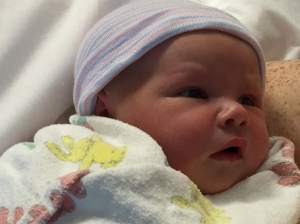
Cameron Nicholas Stewart, named after his uncle Nick.
I was finally transferred out of the ICU on Monday evening and got to move to the postpartum floor to be with Jon and Cameron. A few friends came by that night to bring dinner and love – it was great to have a little normalcy for a few minutes. The next morning, Jon’s mom brought Brooklyn to the hospital to meet Cameron and I’m so grateful to have been able to be there for those moments. In the next few days, we received good care and visits from a few more friends with treats and meals and hugs. In addition, when Jon’s mom had to leave town, our friends picked up the slack and split up the duties of picking up and dropping off Brooklyn from daycare, keeping her overnight, etc.
My parents had planned to come into town the following week, but as soon as I knew about the hysterectomy they changed their flights to get into town much sooner.
The blood tests I took on Tuesday night came back stable – I didn’t need another blood transfusion on Wednesday. Given that, we were able to leave the hospital on Wednesday afternoon to head home. This felt both too soon to leave after such a major medical event and way too long to have stayed in the first place – I was ready to be home.
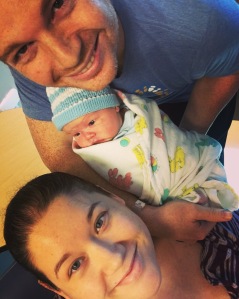
Just before heading home from the hospital.
Cameron is now two and a half weeks old. My parents were here for nearly two weeks but just headed back home themselves, and Jon and I are on our own with two beautiful kiddos. We’ve been the beneficiaries of sweet gestures – people bringing dinner, sending recovery items for me, taking Brooklyn for a morning playdate so we can get a little sleep, and more. #grateful
Recovery has been tough at times – with unexpected things like strong pains in my arms after the IVs, fatigue as my body builds back up my levels of iron after such significant blood loss, and a crampy stomach for several days as my internal systems got themselves organized again after such a crazy few days. At this point, my only remaining “issue” is the still-healing incision. I am so eager to have it all healed up so that I can move again like normal. I don’t like feeling so fragile.
The hospital sent a social worker to speak with us on our last day. She helped us know what to look out for as we process through what we experienced – signs that we were experienced post-traumatic stress, etc. I feel OK emotionally about all of this, which surprises me a little bit. I’m aware that that could suddenly change and I could break down emotionally from the trauma, from the loss of the ability to have another pregnancy, etc. For now, though, I’m OK and very grateful for that.
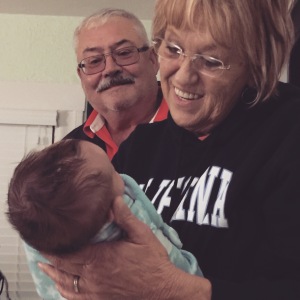
My parents meeting their grandson for the first time.
Life really threw us a curveball with this experience, but there are so many ways it could have been much worse and that perspective has been helpful. I got unlucky in having this condition happen to me, but I got very lucky that I was in a big city hospital with access to the right specialist surgeons and enough blood reserves that doing what it took to keep me alive was possible. My baby boy is healthy, Brooklyn is totally in love with him, and we have family and friends to help us get through this.
Life is still good, and the best is yet to come, I’m sure. Onward.

Apr 27, 2016 @ 19:03:56
Oh my goodness Jess. I’m at a loss for words. Thank you for sharing your story. We do a great job of focusing on the miracles and wonders of a new child, but often times don’t see the hardships of it – whether it’s post-partum depression or surgical emergencies. I’m glad you’re doing well and I hope you do have a smooth and easy recovery. You are blessed in having such an amazing husband and a strong support system. I wish you all the best.
Hugs from AZ.
Apr 27, 2016 @ 23:26:22
Wow. This is an amazing recount of what was surely an incredibly stressful experience. You are so very impressive, on so very many fronts. Blessings and best wishes to you as you move forward raising your beautiful family. Ana-Marie
Apr 29, 2016 @ 23:08:06
Jessica — I am in awe of your strength and resiliance! So thankful that this has turned out the way it has for all of us that love you and your entire family! Cannot wait to meet Cameron and of course to give you a big hug. Let me know when would be a good time to visit.